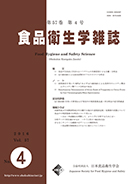
- Issue 6 Pages 179-
- Issue 5 Pages 117-
- Issue 4 Pages 81-
- Issue 3 Pages 67-
- Issue 2 Pages 23-
- Issue 1 Pages 1-
- |<
- <
- 1
- >
- >|
-
Keisuke SOGA, Toshiyuki KAMEI, Akiko HACHISUKA, Tomoko NISHIMAKI-MOGAM ...2016Volume 57Issue 4 Pages 81-88
Published: August 25, 2016
Released on J-STAGE: August 25, 2016
JOURNAL FREE ACCESSA series of accidents at the Fukushima Dai-ichi Nuclear Power Plant has raised concerns about the discharge of contaminated water containing tritium (3H) from the nuclear power plant into the environment and into foods. In this study, we explored convenient analytical methods to measure free-water 3H in foods using a liquid scintillation counting and azeotropic distillation method. The detection limit was 10 Bq/L, corresponding to about 0.01% of 1 mSv/year. The 3H recoveries were 85–90% in fruits, vegetables, meats and fishes, 75–85% in rice and cereal crops, and less than 50% in sweets containing little water. We found that, in the case of sweets, adding water to the sample before the azeotropic distillation increased the recovery and precision. Then, the recoveries reached more than 75% and RSD was less than 10% in all food categories (13 kinds). Considering its sensitivity, precision and simplicity, this method is practical and useful for 3H analysis in various foods, and should be suitable for the safety assessment of foods. In addition, we examined the level of 3H in foods on the Japanese market. No 3H radioactivity was detected in any of 42 analyzed foods.
View full abstractDownload PDF (633K) -
Maki KOBAYASHI, Naoko SAKAI, Kyoko KAMIJO, Harunori OTANI, Masaki HAYA ...2016Volume 57Issue 4 Pages 89-95
Published: August 25, 2016
Released on J-STAGE: August 25, 2016
JOURNAL FREE ACCESSAn analytical method for the determination of fluopicolide in livestock products and seafood was developed using LC-MS/MS. Sodium chloride was added to livestock products and seafood samples and fluopicolide was extracted twice with acetone after acidification with formic acid. The fat from the crude extract was removed using a macroporous diatomaceous earth column, followed by purification with a combination of mini-columns of GC (graphite carbon) and PSA (ethylenediamine-N-propyl silylation silica gel). The average recovery (n=5) of fluopicolide from 10 types of livestock products and seafood (cattle fat, cattle liver, cattle muscle, chicken, eel, egg, freshwater clam, honey, milk and salmon) spiked at the MRLs or at the uniform limit (0.01 ppm) was 96–100%, with a relative standard deviation of 2.3–6.2%. The limit of quantitation of the developed method was calculated to be 0.01 mg/kg.
View full abstractDownload PDF (505K)
-
Asako HIKI, Yukiko YAMAJIMA, Yoko UEMATSU2016Volume 57Issue 4 Pages 96-100
Published: August 25, 2016
Released on J-STAGE: August 25, 2016
JOURNAL FREE ACCESSA method for nicotinic acid (NA) and nicotinamide (NAA) analysis in meats was developed. NA and NAA were extracted from meats or meat products with metaphosphate aqueous solution. The extract was cleaned up with an Oasis MCX cartridge. The cartridge was washed with 2% acetic acid (v/v) and acetic acid–methanol solution. NA and NAA were eluted with ammonia–methanol solution. NA and NAA in the eluate were chromatographed on a Scherzo SM-C18 (3.0×150 mm, 3.0 μm) column with 20 mmol/L ammonium acetate containing 0.1% acetic acid–acetonitrile (97 : 3) as a mobile phase and were monitored at 261 nm. Quantification was performed by LC and LC-MS/MS. Calibration curves showed high linearity (correlation coefficient>0.998) between 1–25 μg/mL for LC and LC-MS/MS. Recoveries were 84–108% (CV≦5.8%) by HPLC and 79–105% (CV≦9.0%) by LC-MS/MS. The limit of quantitation for NA was 0.005–0.01 g/kg and that for NAA was 0.01–0.02 g/kg.
View full abstractDownload PDF (462K) -
Hideo NAGASHIMA, Akiho HIRAO, Yuuki TOKUDA, Kumiko URUTA2016Volume 57Issue 4 Pages 101-106
Published: August 25, 2016
Released on J-STAGE: August 25, 2016
JOURNAL FREE ACCESSA simple and accurate procedure was developed for the determination of seven fungicides, azoxystrobin (AZO), diphenyl (DP), fludioxonil (FLUDI), imazalil (IMZ), o-phenylphenol (OPP), pyrimethanil (PYRI) and thiabendazole (TBZ), in citrus fruits. The citrus fruit sample was extracted with acetonitrile and cleaned up with a graphite carbon/aminopropyl silanized silica gel solid-phase extraction cartridge using acetonitrile–toluene (3 : 1, v/v) as the eluent. Triphenylene was used as an internal standard (I.S.) at the concentration of 0.5 μg/mL. The sample solution was subjected to GC-MS utilizing the matrix-matched standard solution method. The recoveries of AZO, FLUDI, IMZ, OPP, PYRI and TBZ spiked in domestic citrus fruits (Satsuma mandarin) at the level of 0.01–10.0 μg/g were 72.8–104% and the limits of quantification were 0.01 μg/g. The recoveries of DP spiked in domestic citrus fruits at the level of 0.01–70.0 μg/g were 70.8–80.4% and the limit of quantification was 0.01 μg/g. The proposed method was applied to the determination of fungicides in citrus fruits purchased in various markets.
View full abstractDownload PDF (353K)
-
Tamaki SATO, Iori MIYAMOTO, Masako UEMURA, Tadashi NAKATANI, Naoya KAK ...2016Volume 57Issue 4 Pages 107-115
Published: August 25, 2016
Released on J-STAGE: August 25, 2016
JOURNAL FREE ACCESS
Supplementary materialA validation study was carried out on a rapid method for the simultaneous determination of pesticide residues in vegetables and fruits by LC-MS/MS. Preparation of the test solution was performed by a solid-phase extraction technique with QuEChERS (STQ method). Pesticide residues were extracted with acetonitrile using a homogenizer, followed by salting-out and dehydration at the same time. The acetonitrile layer was purified with C18 and PSA mini-columns. The method was assessed for 130 pesticide residues in 14 kinds of vegetables and fruits at the concentration level of 0.01 μg/g according to the method validation guideline of the Ministry of Health, Labour and Welfare of Japan. As a result 75 to 120 pesticide residues were determined satisfactorily in the tested samples. Thus, this method could be useful for a rapid and simultaneous determination of multi-class pesticide residues in various vegetables and fruits.
View full abstractDownload PDF (500K)
- |<
- <
- 1
- >
- >|